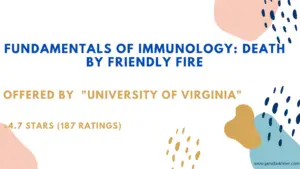Coursera Fundamentals of Immunology Quiz: Death by Friendly Fire | Week (1-4)
Fundamentals of Immunology: Death by Friendly Fire
Offered By ”University of Virginia”
4.7 stars (187 ratings)
Instructor: Alma Moon Novotny, Ph.D.
Enroll Now
Week- 1
Quiz 1
Question 1
1. Both __________ cells have αβ receptors.
- NK; NKT
- NKT; Treg
- Tc; B
- B; γδ
- γδ; TH
- TH; NK
========================================================
Question 2
2. Both ___________ cells and fully adaptive, rearranging their receptor genes randomly and producing a vast number of different receptors.
- NK; NKT
- NKT; Treg
- Tc; B
- B; γδ
- γδ; TH
- TH; NK
========================================================
Question 3
3. Macrophages and NK cells both have ________ receptors.
- CD8 co-
- CD3 co-
- αβ TCR
- γδ TCR
- antibody (Fc)
- inhibitory MHC I
========================================================
Question 4
4. ______ have inhibitory MHC I receptors.
- Only NK cells
- Only Tc cells
- Both NK and Tc cells
- Neither NK nor Tc cells
========================================================
Question 5
5. This picture shows an NK cell interacting with a viral-infected cell. The virus has blocked display of MHC I, although it cannot prevent the cell from showing signs of stress. The NK cell ______ attack because _______.
- will; without MHC I inhibition, the stress ligand will prompt attack
- will; the cell will activate ADCC in the NK cell
- will not; there is no MHC I to activate attack
- will not; there are no antibodies present to prompt ADCC
========================================================
Question 6
6. This picture shows a CTL interacting with a healthy cell. The CTL ______ attack because _______.
- will; it can bind to the peptides displayed the MHC I
- will; the CTL has been activated by the TH cells
- will not; the TCR and CD8 cannot recognize this type of MHC
- will not; negative selection has removed any Tc cells that can recognize the antigen
========================================================
Question 7
7. This picture shows a CTL cell infected with a virus capable of substituting its own fake MHC for the cell’s. The CTL ____ attack because _____.
- will not; the TCR and CD8 cannot recognize this type of MHC
- will not; negative selection has removed any Tc cells that can recognize the antigen
- will; it can bind to the peptides displayed the MHC I
- will; a CTL has been activated by the TH cells
========================================================
Question 8
8. This drawing represents an NK cell from a mouse with a mutation that allows the MHC receptor to distinguish between native MHC and viral analogs. This cell _______ attack viral-infected cells displaying such analogs because these analogs _______.
- will; display viral peptides
- will; will not inhibit attack
- will not; will inhibit the response
- will not; deflect the apoptotic attack
========================================================
Question 9
9. Scientists develop a number of mutant lines of mice with defective CTLs. Which of these, although disabled, nonetheless can still kill viral-infected cells?
- cells with non-functioning perforin genes and functioning FAS-ligand genes
- cells with non-functioning FAS-ligand genes and functioning perforin genes
- cells with non-functioning versions of both perforin and FAS-ligand genes
- A and B, but not C, will both be able to kill viral-infected cells.
- All of these will be able to kill viral-infected cells.
========================================================
Question 10
10. The conversion of LFA integrin on CTL cells from a high avidity conformation to a low avidity conformation triggers which of the following in a TC cell?
- conjugate formation
- fusion of vesicle with perforin and enzymes
- initiation of apoptosis
- signaling to the TH cells
- dissociation from the target cell
Click Here To View Week- 2 Answers
